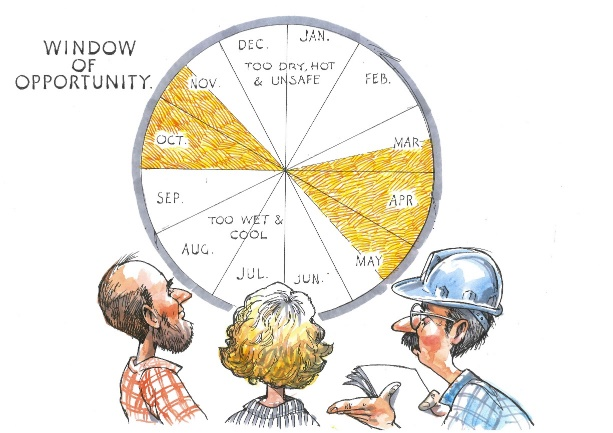Module Objective: Knowing the best times to burn to meet your burn objectives safely and effectively.
To conduct a prescribed burn safely and effectively it’s important to closely look at your local weather patterns. The best time of the year to burn is generally autumn and spring, and potential late summer. This is when the temperatures start to cool and before the autumnal winds start to strengthen and make burning potentially dangerous.
The time of the year to burn depends on the state of the fuel (vegetation) to be burnt and appropriate weather conditions. In damper areas, burning may be confined to the driest months (January and February). Where the fuel has been treated to increase its flammability and where ample good burning weather is available, burning ma be done in March or April, when less hazardous weather conditions prevail.
Generally, it is necessary to take advantage of suitable weather as it occurs, at the same time striking a balance between obtaining a clean burn and keeping the hazard of burning within manageable bounds.

Timing of the burn is the most critical element for obtaining the desire results from the burn. This depends on your burn objectives, if you want a low intensity fire or a fierce quick burning fire. If possible, plan prescribed burn operation¬¬ so that the entire job can be completed within a standard workday.
Have a good understanding of what the weather patterns are going to be on the day, and these are well established before you light the match. Even so, you need to be prepared and have a plan in place should the weather conditions change. Consider not burning if the weather is too variable, or a change in the weather occurs.
You must only light up during daylight hours. Some permit requirements may request the fire is extinguished by nightfall.
Weather patterns are important when deciding what time of day to start a burn.
New Zealand wind tends to change direction before 1pm with the majority increasing in force during the morning, reaching a maximum sometime after midday. The change in force is at times quite sudden.
You need to be familiar with your local and regional weather patterns. Fire generally burns quickly during mid-afternoon when relative humidity is low, and the temperature is higher. In some environments, winds shift or increase during the day.
Examples of this are:
Although these are the general conditions, weather can change at any time of the day, and you must monitor the weather forecast regularly
There are situations where an early burn is acceptable, where:
(what do you mean? Like a fire break? Green paddocks?)Do you mean a burn out, to blacken/remove vegetation? And if so, when do they do this? On the day before they do the burn? Week before etc?(FENZ – what do you mean by early burn? Like when there is dew on the ground, i.e. 5am? Some farmers like to burn then, and would say this is far more safer to do so, than wait till the afternoon. So lets make confirmation on this please.
Depending on your burn objectives, the fuel type, terrain and current season and weather, the burn could start between:
For low intensity burns:
- checkFor hot burns:
checkThere are several reasons for advocating 1pm to 3pm as a window for lighting under normal conditions. They are:
The later start times – 4pm to 6pm, apply to difficult areas that may be burnt only during periods of high fire hazard. The late start after the heat of the day towards evening when temperatures lower and the humidity increases will often result in a satisfactory burn under reasonably safe conditions.
It is not unusual in some localities to find there are perhaps only 2-3 days during the year when conditions are ideal for good burning.
Notes:


Burning is not recommended when:
VC to add in 30-30-30 rule
Self-check:
Qu. What are the typical weather patterns at your location during the season you want to burn?
Qu. When might be a good time of the day for you to burn to meet your burn objectives and the likely weather conditions?
Knowing what your typical weather conditions are like in your area and the appropriate times of the day to conduct your burn.